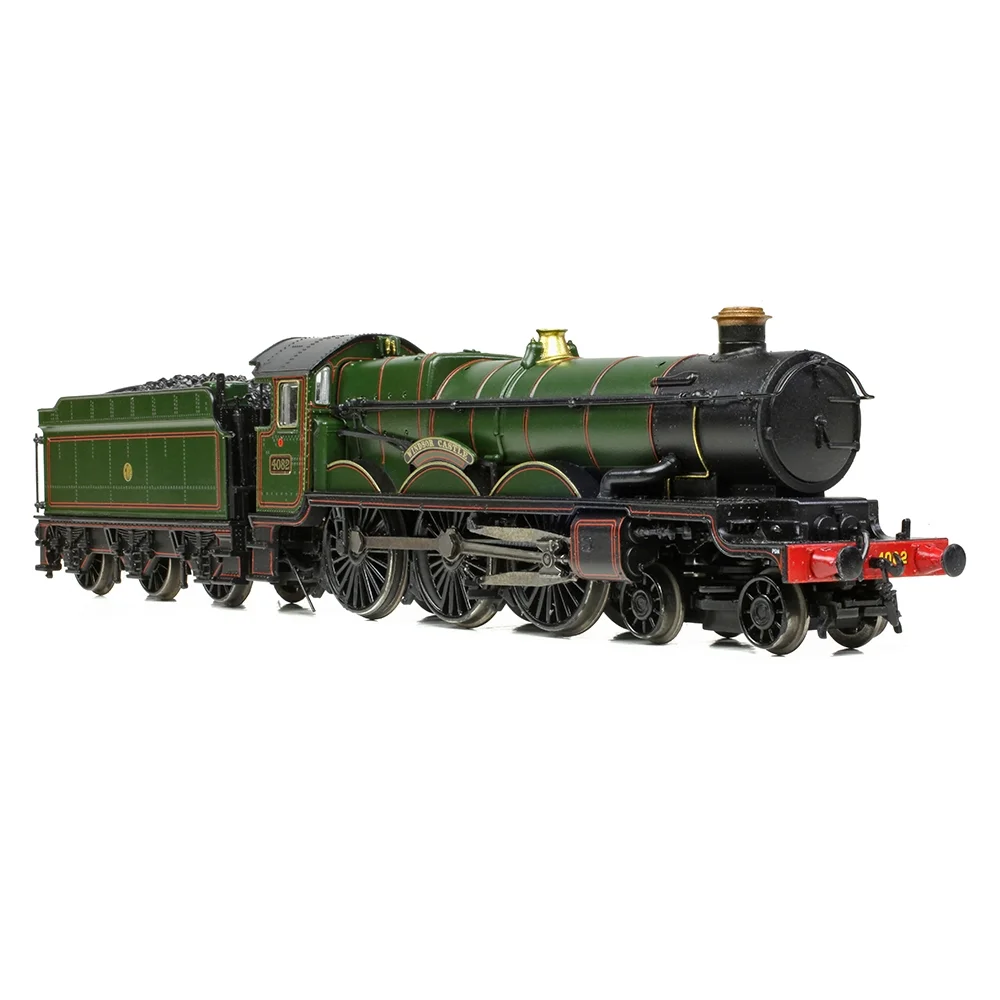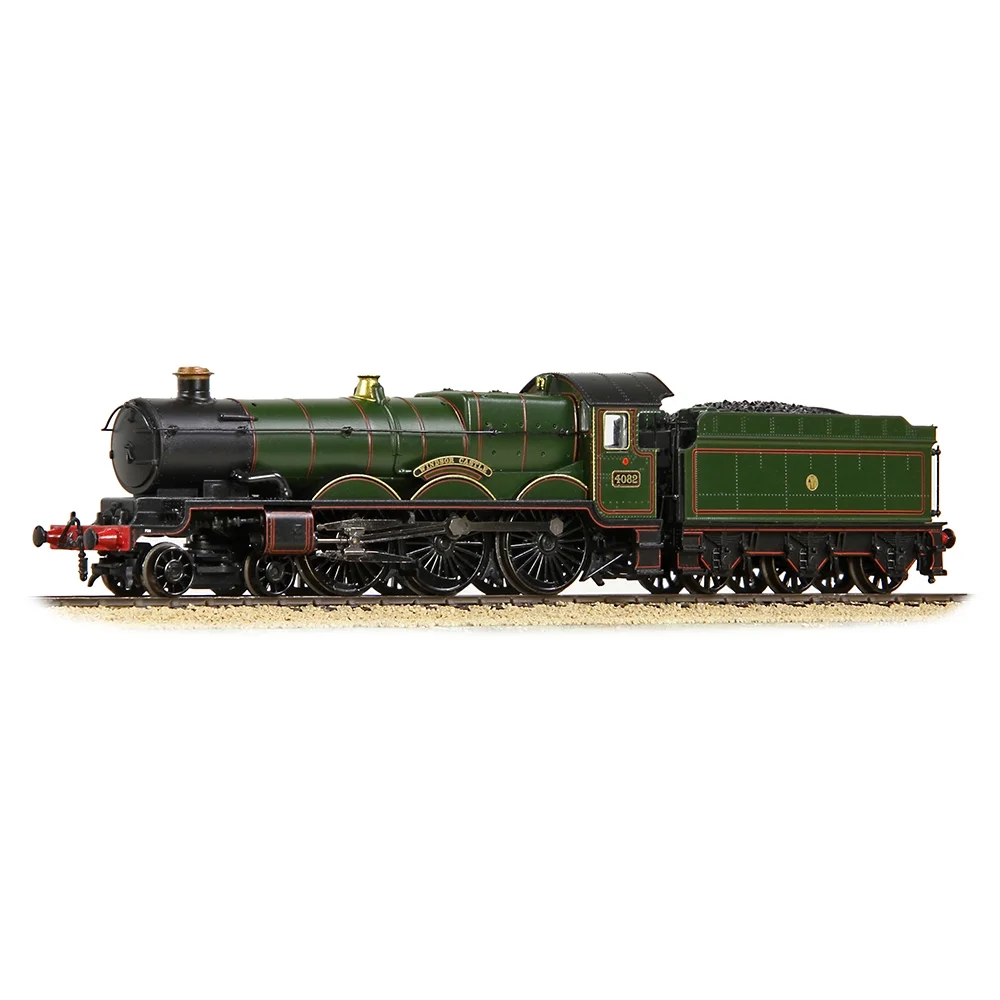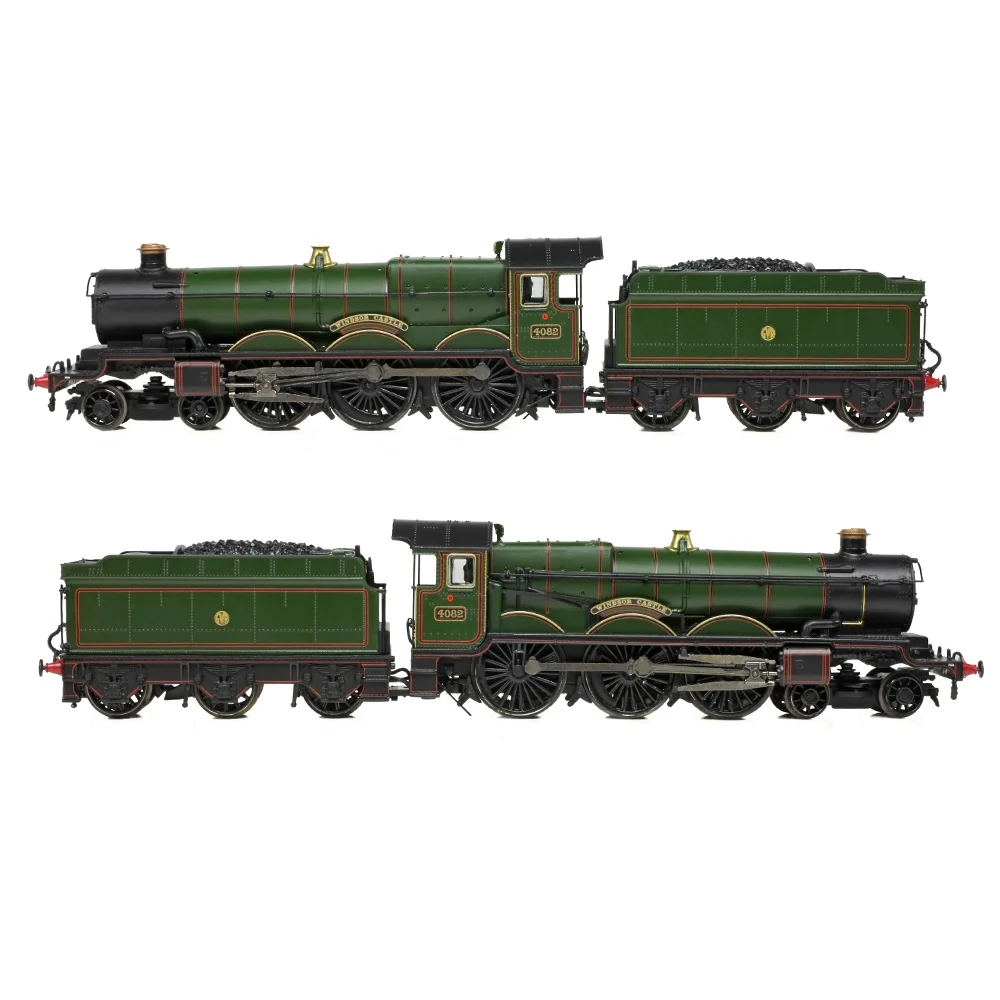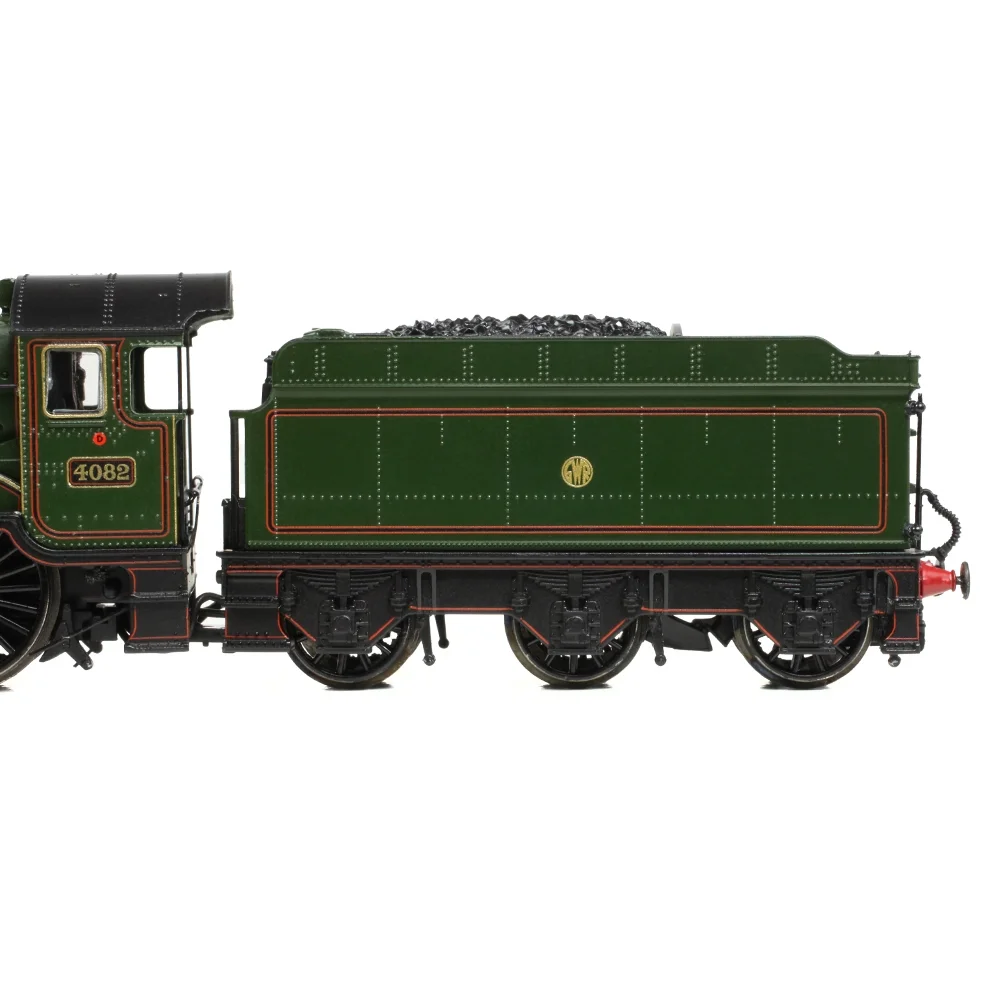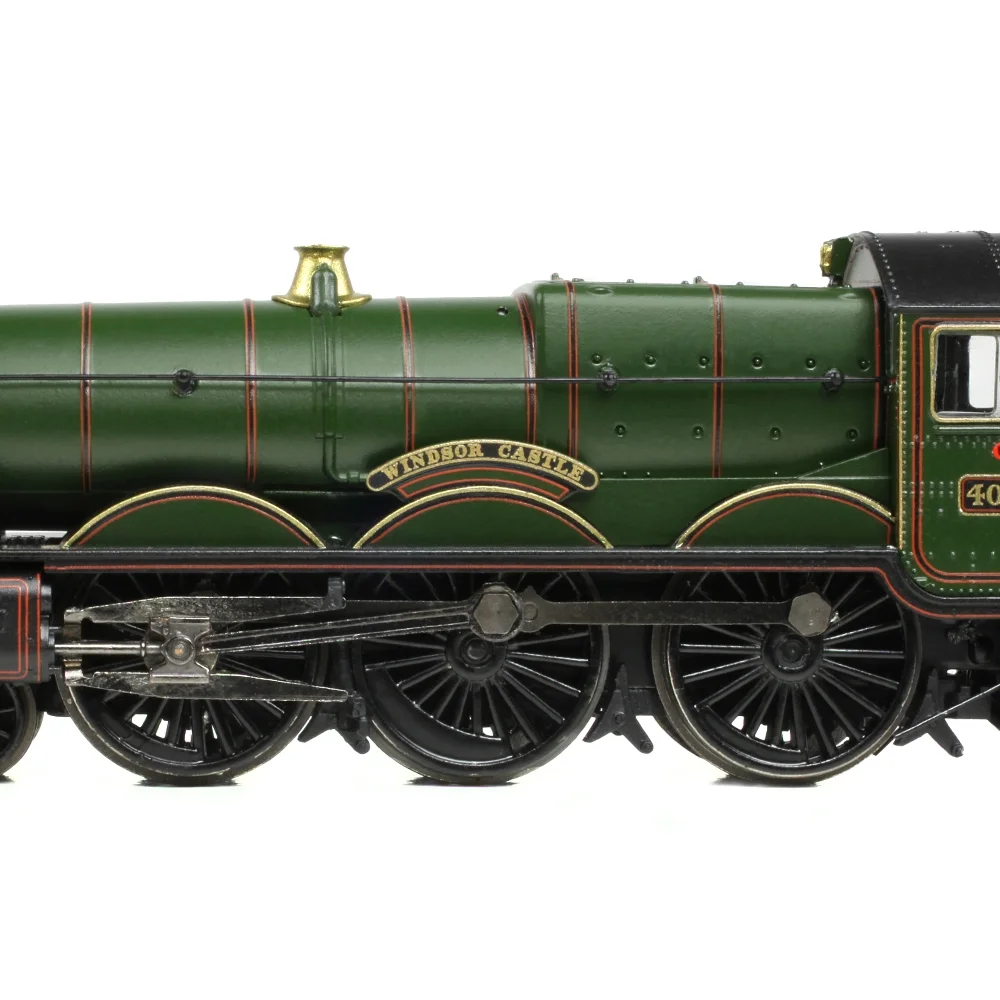Graham Farish 372-035
Great Western Railway 4073 Class 4082 Windsor Castle Great Western Railway Lined Green with Shirtbutton
Graham Farish's Description & Specifications
The Graham Farish Castle Class locomotive is a worthy replica of one of the Great Western Railway’s (GWR) finest steam locomotive designs, with its elegant appearance only amplified by the beautiful lined green livery that was synonymous with the GWR, and later British Railway’s Western Region. This N scale model combines the Castle’s good looks with an exquisite paint finish to produce a masterpiece in miniature fit for any Western-inspired collection.
The model that started a revolution as the first British N Scale steam locomotive to be made with SOUND FITTED, the Graham Farish ‘Castle’ has a technical specification as impressive as its good looks, with a powerful coreless motor driving the wheels through a diecast metal gearbox, all wheel pickup from the driving and tender wheels and separate metal bearings fitted to the driving wheel axles, smooth and reliable running is guaranteed. The tender houses a speaker and Next18 DCC decoder socket, making it easy to add sound, or opt for a SOUND FITTED version and the work is done for you, so you can enjoy realistic sound effects straight from the box on both Analogue and DCC.
- Graham Farish N Scale
- Era 3
- Pristine GWR Lined Green (Shirtbutton) Livery
- Running No. 4082
- Named ‘Windsor Castle’
- Equipped with a Next18 DCC Decoder Socket – Recommend Decoder item No. 36-567A
- Length 145mm (over couplings)
- Part of our Railway Celebrations range
DETAIL VARIATIONS SPECIFIC TO THIS MODEL
- Collett 4,000-gallon Tender
- Single Chimney
- Inside Cylinder Chest: Box Pattern with Curved Front
- Straight Cylinder Steam Pipes
- Tapered Buffers
- Horizontal Cab Side Handrail
- Rear Sandboxes Behind Cab Steps
- Short Nameplates
MECHANISM:
- Coreless motor
- Electrical pickup from all driving and tender wheels
- Separate metal bearings fitted to each driving wheel axle
- Metal bearings fitted to each tender wheel axle
- Diecast metal chassis block
- Diecast metal gearbox, with gearing arranged for prototypical running speeds and haulage capabilities
- 9mm (N gauge) wheels to NEM310 standards with authentic profile and detailing
- Traction tyres fitted to the rear driving wheels for assured haulage capabilities
- Valve gear of metal construction
- Discreet fixed locomotive to tender drawbar with integral electrical connections
- Coupling pocket to NEM355 standards fitted to the front bogie
- Removable coupling pocket to NEM355 standards fitted to the tender chassis
- Designed to operate on curves of second radius (263.5mm) or greater
DETAILING:
- High-precision, injection-moulded bodyshell, running plate and tender with separately fitted details parts including smokebox door, lower front lamp irons, steam pipes, whistle and reverser
- Separately applied metal components including handrails, buffers and sand pipes
- Dome, filler cap, water scoop and vacuum pipe added to the tender as separate parts
- Tender fitted with metal coal-effect load
- Detailed cab interior including boiler backhead controls and gauges, brake standard and water scoop standard
- Hinged and posable metal fall plate between the locomotive and tender
- Each model supplied with a full set of accessory parts including dummy screwlink couplings and front vacuum pipe
DCC:
- Next18 DCC decoder interface located in the tender
SOUND:
- Speaker installed in the tender of all models for optimum sound reproduction
- Zimo MS590N18 DCC Sound Decoder fitted to SOUND FITTED versions
- Sound files produced specifically for the Graham Farish GWR Castle Class using recordings from real locomotives
- SOUND FITTED models operate on DCC and Analogue control as supplied
LIVERY APPLICATION:
- Authentic liveries applied to all models
- Multiple paint applications employed on each model using GWR and BR specification colours
- Logos, numerals and text added as appropriate using multi-stage tampo printing using authentic typefaces, logos and colours
- Named locomotives are supplied with pre-fitted, fully decorated nameplates
Class & Prototype
- Class: Great Western Railway 4073 Class
- Traction: Steam
- Built: 1923-1950
- Total Built: 171
- Running Number: 4082
- Name: Windsor Castle
- Ordered By: Great Western Railway
- Built By: Great Western Railway
- Built At: Swindon
- Built: 04/1924
- Withdrawn: 09/1964
- Length of Service: 40.4 years
- Running Numbers: GWR 4082
- Names: Windsor Castle
The GWR 4073 Castle Class represents the pinnacle of Great Western Railway express passenger design, introduced by Charles Collett in 1923. These legendary 4-6-0 locomotives famously outperformed LNER Pacifics in the 1925 exchange trials, proving their superior fuel economy and performance. With 171 built between 1923-1950, they handled premier services like the "Cornish Riviera Express" for over four decades. Eight survive in preservation, with excellent model representations available from Hornby, Graham Farish, and specialist manufacturers. Essential for any authentic GWR layout.
GWR No. 4082 Windsor Castle was built at Swindon Works in April 1924 as part of the first batch of Castle Class locomotives (Lot 224). This locomotive achieved legendary status when King George V drove it from Swindon Works to Swindon station on 28th April 1924, with Queen Mary also on the footplate alongside senior GWR officials. Commemorative plaques were fitted to mark this royal occasion, making 4082 the designated "royal locomotive" thereafter. Windsor Castle hauled King George V's funeral train in January 1936, cementing its royal connections. However, when King George VI died in February 1952, 4082 was undergoing repairs at Swindon Works. To maintain royal protocol, locomotive No. 7013 Bristol Castle had its identity completely swapped with 4082, taking its number, nameplates, and royal role. After the funeral, the locomotives retained their exchanged identities permanently, though the commemorative plaques returned to the original engine. The original 4082 (now as 7013) was withdrawn in September 1964, whilst the locomotive that became 4082 (originally 7013) lasted until February 1965.
This locomotive represents the pinnacle of GWR public relations success and royal railway heritage, demonstrating how locomotive naming and royal associations could create lasting historical significance.
Operator & Livery
- Operator: Great Western Railway
- Livery: Lined Green with Shirtbutton
- Era: 3 - The big 4 – LMS, GWR, LNER & SR
The Great Western Railway (1835-1947) was Britain's most innovative railway company, engineered by Isambard Kingdom Brunel with his revolutionary 7ft ¼in broad gauge system. Known affectionately as "God's Wonderful Railway" and the "Holiday Line," the GWR connected London Paddington with the West Country, Wales, and Birmingham through 3,800 miles of superbly engineered routes.
Renowned for its Brunswick green locomotives, chocolate and cream carriages, and engineering excellence centred at Swindon Works, the GWR pioneered advanced steam technology under chief mechanical engineers Daniel Gooch, George Jackson Churchward, and Charles Collett. The company's legendary locomotive classes—including Castle, King, Hall, and Manor—established performance standards that influenced British locomotive design for decades.
The only "Big Four" railway to retain its original identity through the 1921 grouping, the GWR maintained its distinctive corporate culture until nationalisation in 1947. Today, the company's engineering legacy lives on through extensive preservation efforts, heritage railways, and detailed model railway recreations that celebrate the finest traditions of British steam railway operation.
The GWR Lined Green with Shirtbutton livery marked a significant modernisation of Great Western Railway corporate branding, introduced in 1934 to replace the traditional "GREAT WESTERN" lettering with a distinctive circular "roundel" monogram. This streamlined design featured the company's standard Middle Chrome Green with orange and black lining, distinguished by the iconic 12-inch diameter gilt roundel with black outline positioned centrally on tender and tank sides.
Nicknamed the "Shirtbutton" due to its resemblance to a shirt button, this modernist logo was created from an official Swindon drawing dated July 1934. The first recorded application appeared on 1 June 1934, initially hand-painted before production transfers became available. The roundel's compact design aimed to provide cleaner, more contemporary branding that reflected 1930s modernisation trends across British industry.
Applied to all locomotive classes during this period—including Castle, King, Hall, Grange, and Pannier Tank locomotives—the shirtbutton livery created visual uniformity across the GWR fleet. However, the 12-inch diameter proved somewhat small on larger locomotives like Collett 4000-gallon tenders, where it could appear insignificant. Many locomotives never received the roundel before it was replaced in 1942 with the more prominent twin shield crest design.
Modelling Note: This livery is authentically represented by manufacturers including Rapido, Bachmann, and Hornby, with Fox Transfers offering accurate roundel decals (reference FRH4101) for detailing work. The period represents an important transitional phase in GWR corporate identity evolution.

